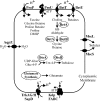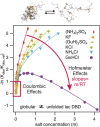Bacterial responses to osmotic challenges
- PMID: 25870209
- PMCID: PMC4411257
- DOI: 10.1085/jgp.201411296
Bacterial responses to osmotic challenges
Figures




Similar articles
-
Structural biology: Clamour for a kiss.Nature. 2008 Oct 16;455(7215):879-80. doi: 10.1038/455879a. Nature. 2008. PMID: 18923500 No abstract available.
-
The glove-like structure of the conserved membrane protein TatC provides insight into signal sequence recognition in twin-arginine translocation.Structure. 2013 May 7;21(5):777-88. doi: 10.1016/j.str.2013.03.004. Epub 2013 Apr 11. Structure. 2013. PMID: 23583035 Free PMC article.
-
Moving folded proteins across the bacterial cell membrane.Microbiology (Reading). 2003 Mar;149(Pt 3):547-556. doi: 10.1099/mic.0.25900-0. Microbiology (Reading). 2003. PMID: 12634324
-
The role of ATP-binding cassette transporters in bacterial pathogenicity.Protoplasma. 2012 Oct;249(4):919-42. doi: 10.1007/s00709-011-0360-8. Epub 2012 Jan 13. Protoplasma. 2012. PMID: 22246051 Review.
-
The AbgT family: A novel class of antimetabolite transporters.Protein Sci. 2016 Feb;25(2):322-37. doi: 10.1002/pro.2820. Epub 2015 Nov 3. Protein Sci. 2016. PMID: 26443496 Free PMC article. Review.
Cited by
-
Characterization of the mechanism of prolonged adaptation to osmotic stress of Jeotgalibacillus malaysiensis via genome and transcriptome sequencing analyses.Sci Rep. 2016 Sep 19;6:33660. doi: 10.1038/srep33660. Sci Rep. 2016. PMID: 27641516 Free PMC article.
-
Cationic π-Conjugated Polyelectrolyte Shows Antimicrobial Activity by Causing Lipid Loss and Lowering Elastic Modulus of Bacteria.ACS Appl Mater Interfaces. 2020 Nov 4;12(44):49346-49361. doi: 10.1021/acsami.0c12038. Epub 2020 Oct 22. ACS Appl Mater Interfaces. 2020. PMID: 33089982 Free PMC article.
-
Dual Role of the C-Terminal Domain in Osmosensing by Bacterial Osmolyte Transporter ProP.Biophys J. 2018 Dec 4;115(11):2152-2166. doi: 10.1016/j.bpj.2018.10.023. Epub 2018 Nov 2. Biophys J. 2018. PMID: 30448037 Free PMC article.
-
Culture-Independent Exploration of the Hypersaline Ecosystem Indicates the Environment-Specific Microbiome Evolution.Front Microbiol. 2021 Oct 28;12:686549. doi: 10.3389/fmicb.2021.686549. eCollection 2021. Front Microbiol. 2021. PMID: 34777269 Free PMC article.
-
Glutamate uptake is important for osmoregulation and survival in the rice pathogen Burkholderia glumae.PLoS One. 2018 Jan 2;13(1):e0190431. doi: 10.1371/journal.pone.0190431. eCollection 2018. PLoS One. 2018. PMID: 29293672 Free PMC article.
References
-
- Cayley S., and Record M.T. Jr. 2004. Large changes in cytoplasmic biopolymer concentration with osmolality indicate that macromolecular crowding may regulate protein-DNA interactions and growth rate in osmotically stressed Escherichia coli K-12. J. Mol. Recognit. 17:488–496 10.1002/jmr.695 - DOI - PubMed
Publication types
MeSH terms
Substances
Grants and funding
LinkOut - more resources
Full Text Sources
Other Literature Sources

